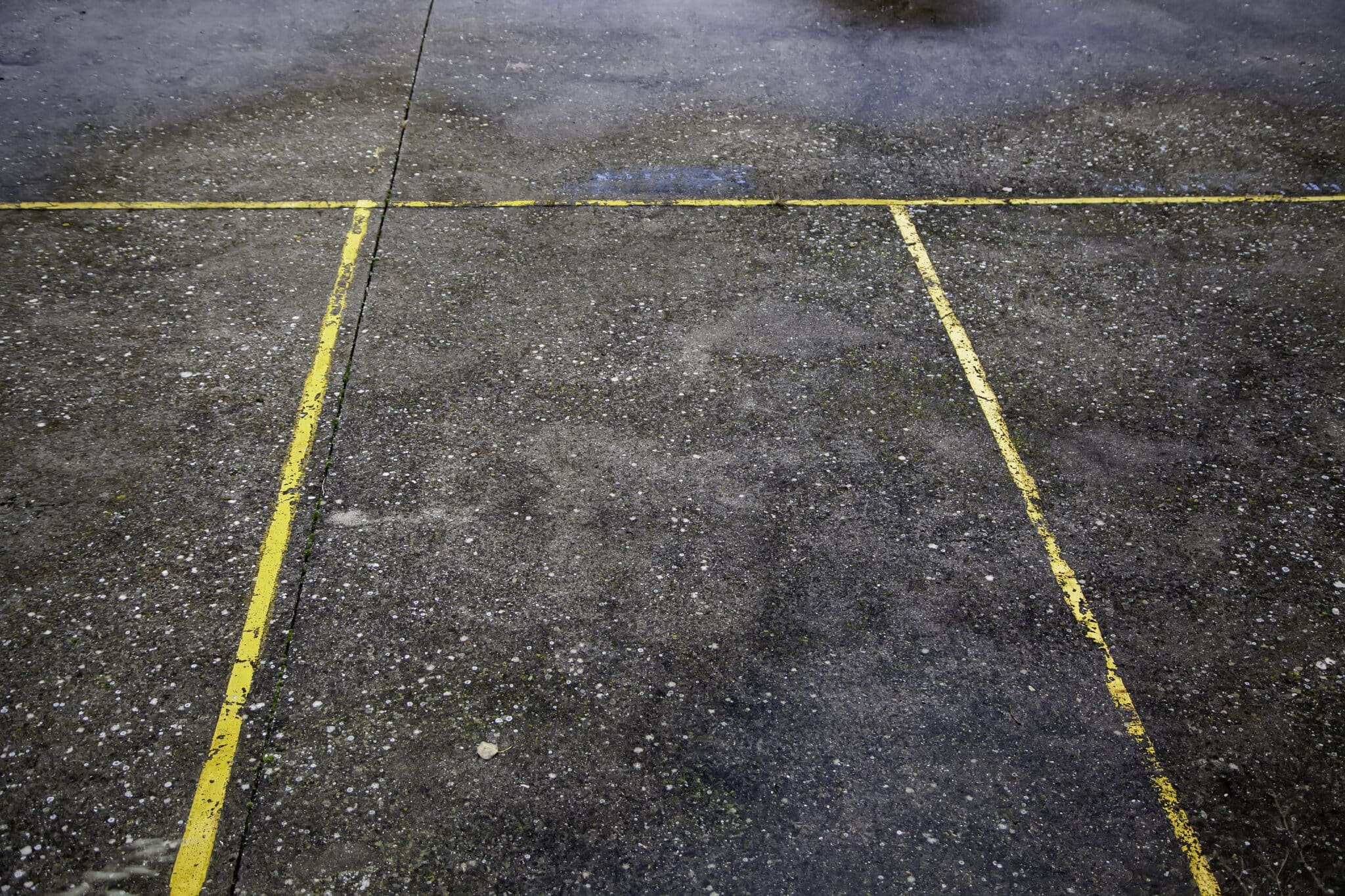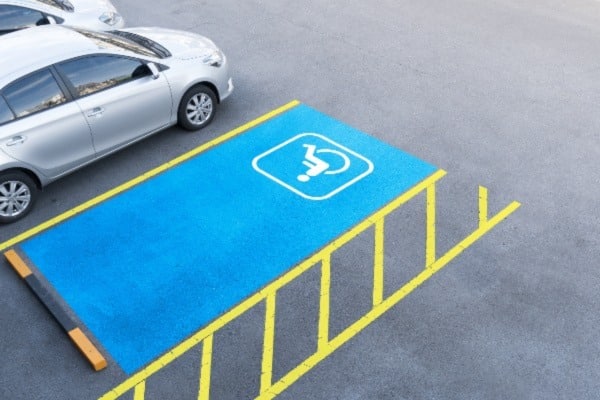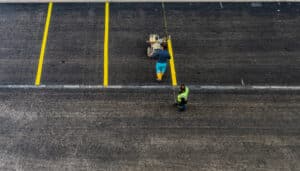Property owners understand that closing their parking lots for temporary maintenance impacts their daily business operations. Parking lots must be routinely painted to adhere to certain regulations for disability spots and spacing. If the parking lot paint is fading or illegible, this is a sign to get it restriped.
Below we’ll break down common parking lot striping FAQs, factors that affect parking lot closure duration, and tips about parking lot striping paint.
7 Parking Lot Striping FAQs: Maintenance, Drying, Lot Closures, Conditions, & Costs
It’s mandatory for property and business owners to be compliant with ADA guidelines for parking lots to prevent liability issues. Whether it’s striping for a new lot or restriping parking lot lines, maintaining parking lot paint must be part of your asphalt’s routine maintenance.
Here are the FAQs about parking lot striping and estimated closing times asked by lot owners and managers.
1. How often do parking lots need to be restriped?
Parking lot restriping is recommended every two years or annually if your lot has heavy traffic flow and harsh weather conditions. Depending on the climate and location, restriping may be warranted more frequently.
2. Will the weather affect parking lot striping?
Yes, the weather does impact parking lot striping, asphalt conditions, and lot closure times for maintenance. Any season works for striping a parking lot, except for winter where it becomes the most challenging due to freezing temperatures and moisture.
Below we’ll break down how each season impacts asphalt striping.
Parking Lot Striping in Summer
Summertime is one of the best seasons for parking lot striping because the paint dries faster in the heat. In return, parking lots can be opened sooner.
Parking Lot Striping in Spring
Asphalt striping in spring can cause longer parking lot closures due to high rainy seasons that impact paint drying times, depending on the region you’re located in. If you need parking lot striping in the spring, schedule it when you know it’ll be a clear forecast so the paint will dry faster. Parking lot paint will still adhere to the asphalt surface when wet, but it takes longer to dry.
Parking Lot Striping in Fall
For fall weather, parking lot lines can be painted for the most part besides the foliage on the ground that needs to be cleaned. When hiring asphalt painting professionals in the fall, ensure to remove leaves, branches, and debris from the lot grounds.
We also recommend preparing your parking lot for winter during the fall by sealcoating and restriping it. Sealcoating parking lots involves applying a thin layer of sealant to the asphalt pavement surface. It fills minor cracks and voids within the asphalt surface to extend the life of your parking lot and paint lines. After sealcoating, parking lot lines are then painted to make a uniform parking lot appearance.
Sealcoating and restriping in the fall helps protect the asphalt from the rigid climate conditions ahead — and prevent significant parking lot repairs that are more costly to fix than preventative asphalt maintenance.
Parking Lot Striping in Winter
In winter weather, freeze-thaw cycles and frost heave occur where snow and ice cause severe wear and tears in asphalt and parking lot paint. For this reason, parking lot striping in winter can take longer to dry due to moisture and cause prolonged lot maintenance closures.
In addition to routine restriping, seasonal parking lot maintenance is crucial to prevent significant asphalt damage, which is more expensive to repair.

3. Does asphalt condition affect line striping paint?
Asphalt conditions do affect striping parking lot lines, but the impact depends on the damage severity. For this reason, it’s key for property owners and managers to invest in sealcoating and parking lot restriping together for routine asphalt maintenance.
How Routine Striping and Sealcoating Minimizes Parking Lot Closure Duration
As asphalt ages over time, especially in heavy traffic and severe weather areas, parking lot paint and asphalt conditions will eventually chip, fade, and break down. Since parking lot paint is typically white, yellow, and blue for disability spots, it can become difficult for pedestrians and drivers to distinguish the paint from the surrounding darker asphalt — creating liability risks, tripping hazards, and more.
For example, dry, rough, and raveling asphalt are signs you need parking lot sealcoating which impact striping because it requires a flat surface to paint within ADA guidelines. In this case, the asphalt must be sealcoated or repaired first before restriping.
By synchronizing parking lot sealcoating and parking lot restriping, it can minimize the amount of time required to close the area for parking lot pavement maintenance and prevent longer closure durations for significant repairs.

4. How long does parking lot striping paint take to dry?
The average time it takes parking lot striping paint to dry depends on weather conditions and lot size. In ideal weather, drying times for parking striping on average is two hours after application for it to be vehicle safe. However, if your parking lot is new or being sealcoated before restriping, paint drying times can be prolonged because the sealant needs to cure first, which takes about 24 hours to dry.
Additionally, the larger the parking lot, the longer the painting process will be. It’s best practice for parking lot owners to follow the paint manufacturer’s label recommendations and directions from their asphalt professionals for exact drying times.
5. Does the type of parking lot paint affect drying time?
For the most part, the type of parking lot paint used doesn’t impact drying times significantly. The most common types of parking lot paints used are water and oil-based. There are other parking lot paint types used to enhance markings, such as reflective paint for easier nighttime navigation and thermoplastic paint for longer-lasting performance. However, weather and asphalt conditions are greater factors that impact drying times than paint types.
6. How much does it cost to stripe a parking lot?
When it comes to parking lot striping costs, it depends on lot size, asphalt condition, and provider. The cost to stripe a parking lot is calculated per linear foot. On average, parking lot striping costs are typically between $0.25 to $1 per linear foot, depending on line width. However, if there’s significant pavement damage, parking lot repairs are required before restriping which will include additional labor costs that are determined by the provider.
7. Can I restripe my own parking lot?
Many property owners ask how to stripe a parking lot to do it yourself. When it comes to painting lines in a parking lot, we don’t recommend DIY striping or restriping. It’s crucial to hire asphalt professionals because they know how to paint parking lot lines within ADA guidelines while prolonging the paint’s life. This can prevent additional costs to restripe and prolong lot closures if done incorrectly because pavement professionals know how to stripe a parking lot within the required standards.
Superior Asphalt Can Revitalize Your Parking Lot Striping Paint
Now that we have answered some FAQs about parking lot striping, you should know how to maintain and care for your parking lot striping. Business owners should make sure they know how to properly care for their newly painted parking lots by sealcoating according to the schedule recommended by their paving contractor.
Ready to revitalize your parking lot striping paint? Superior Asphalt provides parking lot striping paint services and offers asphalt maintenance partnerships with commercial properties in: Arizona, Colorado, Nevada, Utah, and Wyoming. We work with facilities, property managers, and HOA municipal teams to provide the best pavement plans for their needs.
Contact us for a quote or learn how long your parking lot will be closed for maintenance and repairs today!




